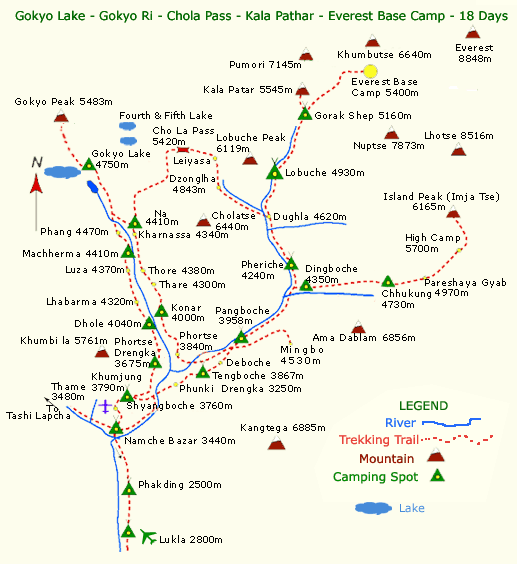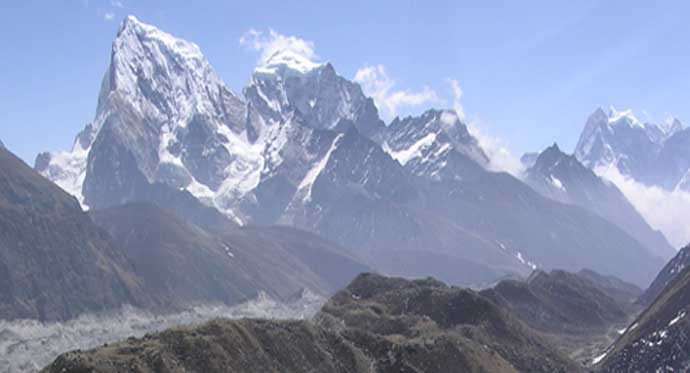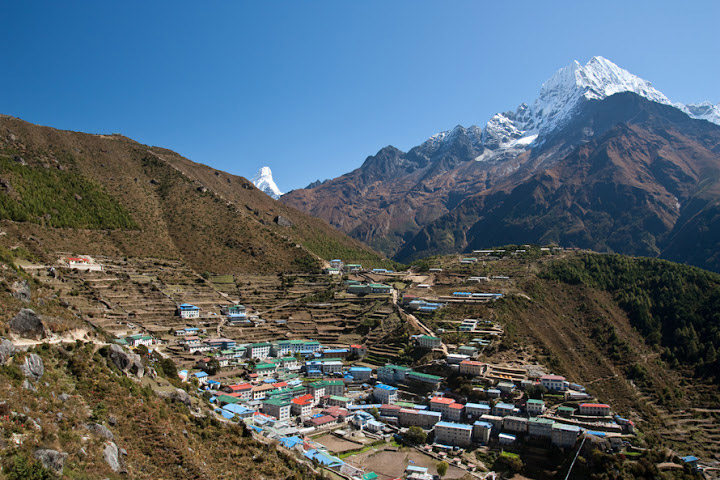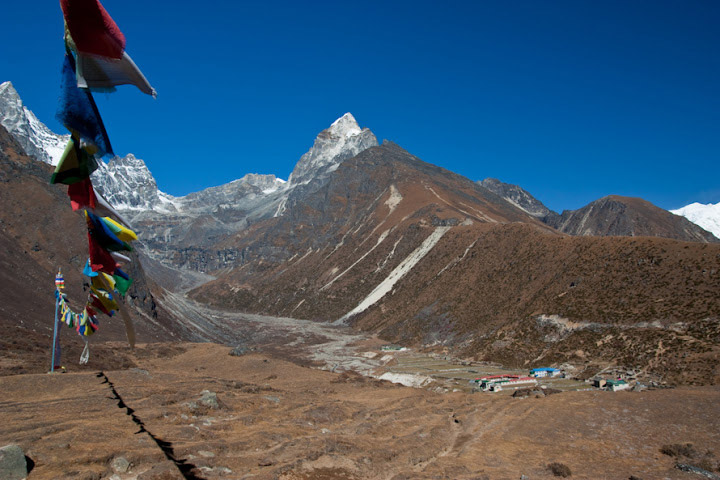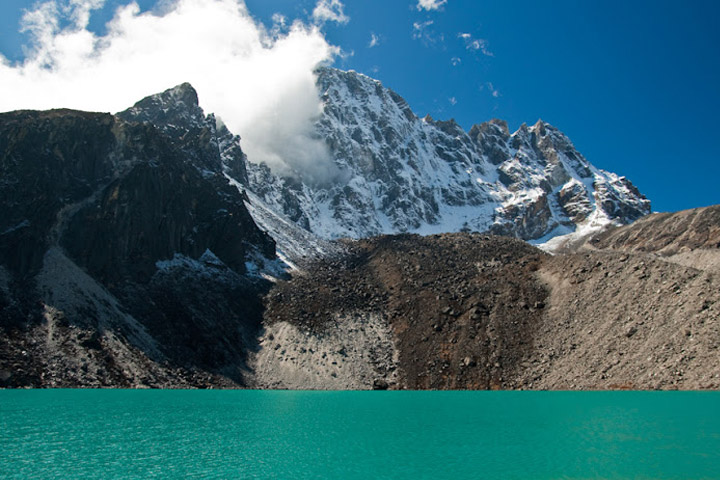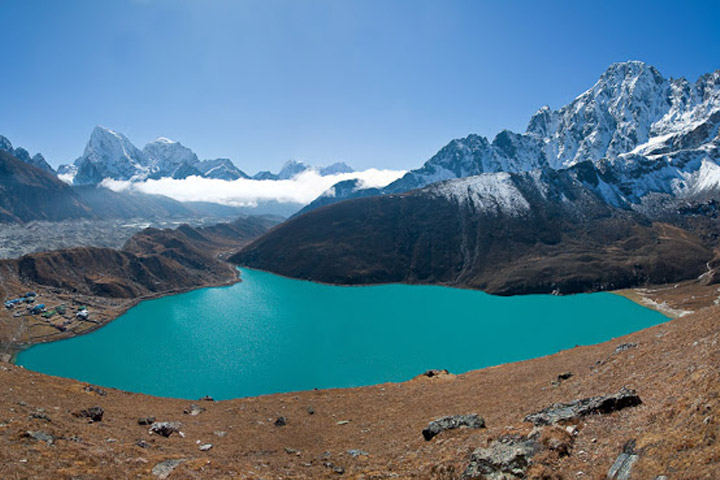Trekking around Gokyo valley is considered a traditional trek that offers magnificent views of the mountain peaks and the Ngozumpa Glacier- the largest in Nepal’s Himalayas. The image of this region is associated with the soaring views of the most popular mountains in Nepal, at an altitude of 8000m such as Cho Oyu, Everest, Lhotse and Makalu which are clearly visible from Gokyo Ri above Gokyo Lake. One of the most remarkable features is the views of the tremendous ice ridge between Cho Oyu and Gyachung (2922m) located in Khumbu region.
After a thirty five minute flight from Kathmandu landing at Lukla’s tiny airstrip, the adventure really begins. We spend the next few days trekking and interacting amongst the mountain people also known as Sherpa’s, we stay at local lodges and trek into the heartland of their villages. Everything is organized in conjunction with local Sherpa guides. Along the trek we will pass Buddhist monasteries with the views of Everest and other snow towering mountains getting closer by the day. We will have rest days in the villages of Namche bazaar that will allow us to explore the region and acclimatize, which is very important. After trekking to Gokyo Ri (5483 meters), we return at a leisurely pace back to Namche and Lukla for our flight back to Kathmandu.
Day 01- Arrival in Kathmandu airport (1345meters).
There you will be met by our Airport Representative and transferred to hotel by private tourist vehicle. Overnight at hotel.
Day 02- Sightseeing around Kathmandu valley.
In the morning after breakfast at 9 AM, we host a Pre-Trip meeting at your hotel in Kathmandu and introduced your trek Leader/Guide mean time and it will provide an opportunity for individuals to ask questions about the your trek and to introduce you to other participants. This includes a final briefing and preparations for the trip.
PLEASE ADVISE US IF YOU WILL BE ARRIVING LATE AND ARE THEREFORE UNABLE TO ATTEND THE PRE-TRIP MEETING.
In THE PRE-TRIP MEETING All passengers MUST bring:
1. Passport.
2. Four copies of Passport size photos each.
3. Travel Insurance Policy.
4. A writing pen
5. Notepad.
After the Pre-Trip meeting and breakfast your sightseeing trip will start at 9.45 AM in the morning. We provide a private vehicle and professional tour guide. We visit Bodhnath Stupa, one of the biggest Buddhist shrines in the world, where we observe Buddhist monks in prayer in the monasteries surrounding the stupa. After Bodhnath Stupa we visit Pashupatinath, the most famous Hindu temple in the country, located on the banks of the holy Bagmati River. Here we see Hindu holy men (sadhus) meditating, pilgrims bathing and occasionally funeral pyres burning on the ghats. We also visit Bhaktapur Durbar Square, which is a collection of pagoda and shikhara – style temples grouped around a fifty-five-window palace of brick and wood. The attraction of the Bhaktapur Durbar Square is The Lion gate, The Golden gate, The Palace of fifty five windows, Art Galleries, The Statue of King Bhupatindra Malla.
The rest of our time in Kathmandu is free for further exploration and some last-minute shopping in Thamel area near by your hotel. Later, we are supplied with our Trek Pack and departure information for tomorrow. Overnight at hotel.
Day 03- Fly to Lukla (2804 meters) trek to Phakding (2610 meters) 3 hours.
An early morning start takes us to Tribhuwan international Airport in Kathmandu for the 35 minute scenic flight to Tenzing and Hillary Airport at Lukla at 2804meters. On arrival at the airport guide will brief you and introduce our porters before we begin our trek towards Phakding at 2610meters.
After landing we have time to explore the village while our Sherpa crew sort and load our trekking equipment. Then we begin our trek by descending towards the Dudh Kosi River where we join the main trail to Namche Bazaar, located just above Chaunrikharka (2713m). The walking is easy and after passing through the small village of Ghat (2550m) it is a short walk to Phakding. Overnight at Guesthouse.
Day 04- Trek to Namche Bazaar (3441 meters) 5.30 hours.
We continue trekking along the banks of the Dudh Kosi, crossing this majestic river many times on exciting suspension bridges laden with prayer flags. After entering Sagamartha National Park, the trail climbs steeply with breathtaking views. Namche Bazaar known as the Gateway to Everest which is home to many quality restaurants, hotels, lodges, shops, Money exchange, internet cafe and a bakery. Namche is one of the biggest villages along the whole Everest trail. Overnight at Guesthouse.
Day 05- Namche Bazaar Acclimatization day.
We will spend a day here in order to acclimatize and adjust to the thinning of the air. A short trek to a museum celebrating the traditional customs of the Sherpa people. Today we hike up the Syangboche Airport, and around Everest View Hotel. From this point, we have rewarding views of the Himalayas with a stunning sunrise or sunset over the panorama of the Khumbu peaks. Overnight at Guesthouse.
Day 06- Trek to Phorste Thanga (3680meters) 5 hours.
Today, the trail climbs steeply out of valley through rhododendron forest, juniper and large conifers start to appear as the elevation increases making trekking beautiful in spring. The trail passes through Yak Kharkas and summer settlements. The views of Khumbi La and Tawache are magnificent throughout the day. Overnight at Guesthouse.
Day 07- Trek to Machherma (4470 meters). 5 hours.
The trail climbs a ridge for an excellent view both down the valley to Kengtega and up towards Cho Oyu and descend to a river and again climbs steep to the terminal moraine of the Ngozumpz glacier. We will reach at Machherma by early noon. Overnight at Guesthouse.
Day 08- Trek to Gokyo (4790 meters) 5.30 hours.
Today the trek takes us at one of our final destination, Gokyo (4790m). We will make this camp our base for 2 nights as we will have couple of hiking and sightseeing trips around Gokyo. Overnight at Guesthouse.
Day 09- Trek to Gokyo Ri (5483 meters) and then Back to Gokyo. 5 hours.
Today, early in the morning we have steep climb up to the top of Gokyo Ri at elevation of 5483 meters, ample rewards to anyone that attempts this trip. There are stunning views of the supper Gokyo valley, the massive Ngozumpa Glacier and an incredible panoramic view of the whole Khumbu Himalayas, such as giants as Everest, Lhotse, Nuptse, Makalu, Cho-Oyu and Gychung Kang can be seen. Those who explore the glacier and Gokyo peak are rewarded. This day we have for acclimatization and after noon back to the camp. Overnight at Guesthouse.
Day 10- Trek to Dole (4200meters) 6 hours.
Following same trail down, we will make our descent to Dole. Overnight at Guesthouse.
Day 11- Trek to Namche Bazaar via Khumjung village (3780meters) 5 hours.
Descend to Namche Bazaar via typical Sherpa village of Khumjung . Leaving the mountains behind us our descent continues back to the town of Namche Bazaar at elevation of 3441meters. Overnight at Guesthouse.
Day 12- Trek to Lukla (2804 meters.) 6 hours.
Finally we return to Lukla where the trek began, which will seem like a lifetime ago. Enjoying time to reflect on the trek as a group and the personal achievement of all those who took part. Also giving you time to explore the town. Overnight at Guesthouse.
Day 13- Morning flight to Kathmandu from Lukla
Enjoying your last glimpse of the mountains you have recently visited for one last time on the 35 minute Scenic flight back to Kathmandu. On arrival in Kathmandu we are met and transferred back to our starting hotel. Overnight at hotel.
Day 14- Leisure day in Kathmandu.
It’s also spare day in case of bad weather in Lukla. If you are interested in continuing onto Chitwan Jungle Safari, River Rafting Adventure, Kathmandu Shopping Tour or Scenic Everest Flight.
Day 15- Transfer for your final flight departure.
The trip ends, our Airport Representative will drop you to the Kathmandu international airport for your flight departure from Nepal.
Note: The above information is a guide and standard template of what we provide. The trek can be customized at your request to accommodate your specific requirements.
Note : On adventure trips of this type, weather, local politics, transport or a multitude of other factors beyond our control can result in a change of itinerary. It is, however, very unlikely that the itinerary would be substantially altered; if alterations are necessary the leader will decide what is the best alternative, taking into consideration the best interests of the whole group. Where a change does occur, we do everything we can to minimize its effect, but we cannot be responsible for the results of changes or delays.
Q.What type of shape do I need to be in, is this trip for me?
A. Trekking is suitable for average people who are moderately fit, thus no previous experience is required. Some physical fitness programs such as running, swimming, hiking is recommended before you embark on your journey. Persons suffering from a pre-existing medical condition or disease must seek medical advice before considering the trek. Whilst on the trek, it is common to experience some discomfort before being fully acclimatized.
To prepare for a strenuous trek you should begin training at least two to three months before your departure. As a guideline, an hour of aerobic exercise three to four times per week would be considered a minimum requirement. The best preparation is bushwalking involving relatively steep ascents and descents. If you can manage a couple of valley floor to ridgeline ascents per comfortable and able to enjoy the trek to the fullest. They are physically strong, sharp-witted and have an incredibly positive attitude towards a life that we would consider extremely tough. There is something about a trek in the Himalaya that draws you back time and time again. For keen walkers it is a paradise and even avowed non-walkers find that one foot just seems to follow the other, drawn by the appeal of what lies beyond.
Q. Will somebody come to pick me up at the Airport upon my arrival?
A. Yes, our Airport Representative will be there to greet you outside of Terminal Hall, he/she will be displaying an Kiwi Adventures Treks & Expedition sign board. Upon arrival, you will be transferred to your hotel.
Q. What sort of accommodation can I expect in Kathmandu and in trekking?
A. 11 night’s Trekking Guesthouse, 4 nights three/four star hotels in Kathmandu.
We use standard rooms from three/four star hotels in Kathmandu with breakfast included. Along the trekking routes teahouses/Lodges generally provide basic clean facilities with a mattress and a quilt or blanket. We can also offer you sleeping bags if needed (which need to return after the trip) but it is a good idea to always have your own sleeping equipment. We usually provide single and double rooms as well as the occasional dormitory. The dining room is downstairs around a fire. All food will be cooked to order in the little kitchen. You should not enter the kitchen unless asked to do so.
Q. What sort of food can I expect in trekking?
A. In trekking most teahouses (lodges) cook a delicious range of mostly vegetarian fare. Pasta, tuna bakes, noodles, potatoes, eggs, dhal bhat, bread, soups, fresh vegetables (variety depends on the season) and even some desserts like apple pies, pancakes, and some interesting attempts at custard. You will find a lot of garlic on the menu because it assists with acclimatization – eat some every day. In many larger villages you may find some meat on the menu. You can always get hot chocolate, tea, and hot lemon drinks, as well as soft drinks, and treats like chocolate and crisps.
Each day dinner and breakfast are used to take in the same lodge you spend the night. Lunch will be taken on the way to destination.
Q. What sort of transportation you use?
A. Kiwi Adventures Treks & Expedition is all about providing you with local insights as well as adventure, with that in mind, where we think you will get more out of your holiday by using different means of transport that is what we do. Using a variety of private transport is an integral part of our Himalaya tours and enhances the experience!
We use private tourist vehicles for sightseeing, city tours and pickups. Depending on the group size we use cars, minibus, van or land cruiser. These small light vehicles are more manoeuvrable and flexible enabling us to take you through the Narrow roads of Nepal. All the vehicles are usually air-conditioned unless we are travelling in cooler areas.
Q. What is the best season for this trekking?
A. Our trekking season extends from mid- September to May. From early September the monsoonal rains decrease. By end of September through to December the weather is usually stable with mild to warm days, cold nights. February, March, April, May, October, November, December are the best time to do trek.
Q. What is the weather & temperature like in trekking?
A. Weather in the mountains is notoriously difficult to predict. At night it is generally cooler the days are generally warm. Winter (January and February) will be bit colder but the days can be quite beautiful and warm if the sun is out. There will be bit of snow during the month of January, February and December. It is also important to make sure that you can stay warm and dry in just about any conditions. Expect the unexpected! The temperature could be as high as 20 deg C to -15 deg C low.
Q. Can I charge my digital camera or other batteries on my trip?
A. These facilities will be available in most of the places in your hotel reception by paying some service charges. Remember to bring your adapters!
Q. Is there any communication while we are on trekking?
A. There are telephones in some villages along the trekking routes from which you can make international calls.
Q. Can I use credit cards in the places visit in trekking?
A. In most cities yes, to some extent, however once you leave those cities behind, all you need is cash.
Q. How much additional money do I need per day?
A. In Kathmandu, you can allocate US$ 10 – 25 for a lunch / dinner. It’s all depends on your spending habits. US$7 to 10 US$ a day will be enough to buy bottles of water, chocolates and few drinks in trekking.
Q. Do I need to tip my guide and porters? How much would that be?
A. This is a difficult thing to gauge. We have seen everything from 20USD to 1000 USD per person for guides and porters. Tipping is not required, but a small way to show your guides and local porters thanks for their help. The level of the tip should reflect the level of personal involvement with your guide.
Q. Is the water OK to drink? Do I need to bring purifying tablets/filter?
A. In most places bottled water is readily available. If you wish to drink normal water, you need to use purifying aid, which you will need to bring with you.
Q. Are the Kiwi Adventures Treks & Expedition staff insured?
A. Our company insures all our trekking staff, including guide, cook, sherpa and porters.
Q. What essential documents do I need to bring with me on tour?
A. *Valid Passport – must be valid for up to 6 months after you return from your tour, keep a separate photocopy.
*Travel insurance, keep a separate photocopy
*Cash and Traveller’s Cheques, keep numbers and proof of purchase separate
*Flight tickets
*Emergency contact numbers for T/C’s, banks, insurance, family contacts.
Q. Can I add extra days to my trekking trip?
A. A hoilday should never be about making it to the final point quickly. Along your trek we can add days at your request with additional costs to cover guides, porters, accommodation and food.
Q. Do you use yaks/porters on the trek or do we carry all of our own gear?
A. Whilst on the trek, our porter will take care of your luggage. All you need to carry is your small day bag for your personal belongings like camera, water bottle, sun cream etc only.
Q. What opportunities will I have for shower along the trek?
A. In major places, we arrange guesthouse with hot shower. And in rest of the places, hotel water in bucket will be provided for shower; it would cost you extra about USD 3-4 per shower.
Q. Do you know about how many total miles the trek is?
A. Total distance of the entire trek is about 75 miles.
Cost Includes
• Airport / Hotel / Airport pick up & drop by private car / van / bus.
• Standard twin sharing accommodation in three/four star hotel in Kathmandu breakfast included. (4 nights)
• Guided city tour in Kathmandu by private car / van / bus.
• All your standard Meals during the trek (18 Breakfasts, 14 lunches, 14 Dinners).
• Twin sharing Lodges, Guesthouses accommodation during the trek (14 night’s Trekking Guesthouse).
• Local Ace the Himalaya licensed English speaking Guides.
• The required number of local staff and Porters to carry your luggage during the trek.
• Food, accommodation, salary, insurance, equipments, medicine for all trekking staff.
• Everest National Park permits.
• Airfare from Kathmandu – Lukla – Kathmandu including airport departure tax in Kathmandu and Lukla airport.
• Surface transfer from and to Kathmandu.
• Sightseeing/Monument entrance fees.
• All our government taxes.
• Official expense.
Cost Excludes
• Lunch and dinner whilst in Kathmandu.
• Your travel insurance (compulsory).
• International airfare and airport departure tax.
• Nepal entry visa, you can obtain a visa easily upon your arrival at Tribhuwan International Airport in Kathmandu. (US$ 25 or equivalent foreign currency is required to obtain Tourist Visa with Multiple Entry for 15 days. Likewise, Tourist Visa with Multiple Entry for 30 days can be obtained by paying US $ 40 or equivalent foreign currency. Similarly, Tourist Visa with Multiple Entry for 90 days can be obtained by paying US $ 100. You will also require 2 passport size photos.)
• Alcoholic, hot and cold drinks.
• Personal trekking Equipment.
• Tips for trekking staff (Tipping is expected.)
• Any others expenses which are not mentioned on Price Includes section.
